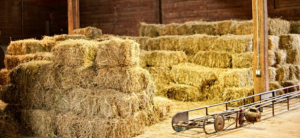 Sampling Techniques for Hay Analysis: Accurate hay analysis depends on sample quality. In short, laboratories cannot do a worthwhile job if they have only poor samples to analyze. Laboratory personnel tell stories of receiving a complete flake or slab of hay, a handful of hay pulled from a bale or grabbed from the hay feeder, or a small wad of hay cut up with scissors. These submissions are not quality samples and cannot be used by a laboratory.
Sampling Techniques for Hay Analysis: Accurate hay analysis depends on sample quality. In short, laboratories cannot do a worthwhile job if they have only poor samples to analyze. Laboratory personnel tell stories of receiving a complete flake or slab of hay, a handful of hay pulled from a bale or grabbed from the hay feeder, or a small wad of hay cut up with scissors. These submissions are not quality samples and cannot be used by a laboratory.
Any sampling of dry forages that involves grabbing a handful of material usually results in a subsample that is poorer in quality than the actual nutrient content. This is particularly true with alfalfa (lucerne) hay because grab sampling typically results in mostly stems, with the finer and more fragile leaves shaking off. Leaves contain most of the nutrients, being higher in both protein and digestibility than the stems. Any procedure that results in leaf loss will have a negative impact on the analysis. The opposite also holds true. Sampling that results in concentrating the leaves will make the sample look better than the forage actually is.
Proper Hay Sampling:
The only way to obtain a proper hay sample is by using a bale probe or corer. This is typically a metal tube from 38 to 48 cm (15 to 18 in) long and sharpened at one end. The type of probe depends. It is either hand-operated or may be coupled to an electric drill. Feed stores and agricultural extension offices may have corers that can be borrowed.
Probe bales properly. The center of the small, square end is the right spot. The probe takes a representative cross section as it spins and cuts its way through the bale. The resulting core sample will proportionately reflect the leaf and stem material in the bale. Typically, obtaining and combining core samples from 10 to 20 bales will form a worthy composite sample.
Article Sources: Kentucky Equine Research
